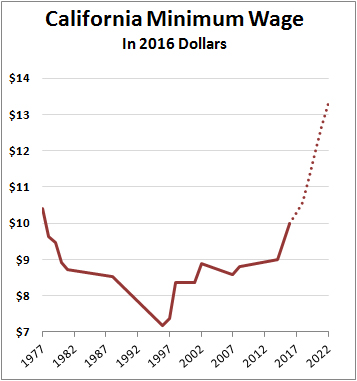Much of the leftosphere has been uncritically cheering the likelihood that California will move its minimum age to $15/hour. I am therefore glad that Kevin Drum has raised a cautionary note. As Kevin points out, modest raises in the minimum wage do not seem to produce increased unemployment, but this would not be a modest raise:
This would genuinely be terra incognita. The chart shows the California minimum wage over the past 40 years, adjusted for inflation. An increase to $11 per hour in 2018 would return the state to slightly above its historical high point. Beyond that, however, the minimum wage goes far higher than it’s ever been.
When I look at Kevin’s chart, my hunch is that in wealthier, high wage areas such as Silicon Valley and San Francisco, the effect of even this big increase will be a net positive. But in poorer California counties, the law is mandating that a full-time job must pay more than the current annual median income. From where is all the money to pay these wages going to come in low-income areas? Will the local family who runs a gas station or a convenience store on a tight margin in El Centro truly start hiring cashiers at a rate higher than what the store manager currently makes? And how will people on fixed incomes (e.g., Seniors living on social security) in low-income counties survive as the wage increases in different sectors increase the price of food, clothing and health care?
My fear is that because the media and scientists are clustered in wealthy, urban areas, the potential negative impacts of this wage experiment on poorer, rural areas will not be noticed. I hope the law mandates a well-funded evaluation of whether the whole state truly benefits from setting a uniformly high minimum wage.

One thought on “Potential Downsides of a $15 Minimum Wage”
Comments are closed.